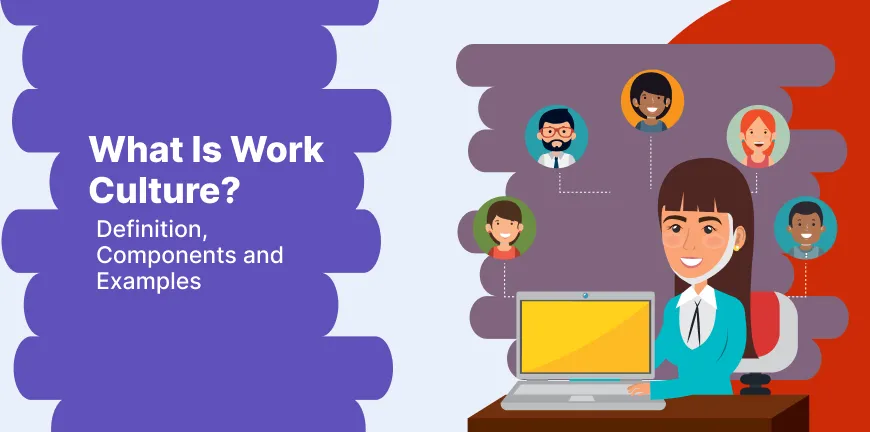
NATS vs NAPS: Which Apprenticeship Scheme is Right for You?
12/10/2025
8 types of Human Resources Positions: Salaries, Skills, Career Growth
12/10/2025- What is Work Culture?
- Work culture definition and meaning
- How is Work Culture different from corporate culture
- Why is it more than just perks
- Why Work Culture Matters
- Types of Work Culture
- Core Components of a Healthy Work Culture
- Signs of a Positive vs. Toxic Work Culture
- Real-World Examples of Great Work Cultures
- How to Build a Positive Work Culture
- Adapting Work Culture to a Changing Workforce
- Work Culture Trends in 2025 and Beyond
- Conclusion
- Key Takeaways
- FAQs
Most professionals struggle to define work culture despite its profound impact on our careers. A recent survey revealed that 64% of Indian workers would pick a company based on its organizational culture. This data highlights how workplace culture has become a vital factor in today’s competitive job market.
Companies with positive cultures have happier employees as they feel valued and supported. Organizations with strong work cultures achieved a remarkable 682% revenue growth over an eleven-year period.
This article will help you understand the concept of workplace culture and its various types. You’ll learn to spot the difference between positive and toxic environments. We’ll examine real-world examples of successful work cultures and provide you with practical steps to create a culture that works for your organization and its employees.
What is Work Culture?
Each organization has a unique personality and atmosphere that shapes how people work and interact. Work culture encompasses the values, expectations, and practices that shape interactions between employees and management.
Work culture definition and meaning
Work culture reflects how leadership practices, employee behavior, workplace amenities, and organizational policies affect workers and internal stakeholders. The attitude, belief, and perception of an employer shape the workplace culture.
Work culture forms a shared system that motivates employees to achieve personal and organizational goals. Both formal elements, such as policies and procedures, and informal elements, including unwritten rules and social norms, play crucial roles.
The key components that shape work culture are-
- Leadership and management behaviors
- Employee attitudes and interactions
- Organizational policies and procedures
- Institutional values and mission
- Workplace facilities and amenities
These elements can either create an environment that supports or undermines employees. A positive work culture leads to better outcomes for staff and the organisation, while a toxic one results in poor teamwork and decline.
How is Work Culture different from corporate culture
People often use the terms ‘work culture’ and ‘corporate culture’ interchangeably, but subtle differences matter. Corporate culture represents the shared values, goals, and operational principles at an organization’s strategic level, primarily influencing its external impact.
Work culture focuses on employees’ daily experiences—the reality people face, which can vary between teams or departments. Furthermore, it reveals the current environment rather than just stating values.
Corporate culture reveals what an organization claims to be, while work culture shows what employees experience on a daily basis.
Organisations struggle when their external image clashes with employees’ internal experiences, leading to disengagement and staff turnover. Surface-level changes in corporate culture often fail to improve the actual workplace experience.
Why is it more than just perks
Many people think work culture means fancy perks like free lunches, unlimited time off, or ping-pong tables. These amenities only scratch the surface. A strong culture emerges from how companies value, trust, and support employees in their professional and personal growth.
Culture acts as your organisation’s operating system – embedded values, beliefs, and behaviours guide how people interact and complete work. A solid work-life balance program showing genuine care for employees makes a real difference.
An authentic work culture plays a vital role in success. Research shows 78% of executives rank culture among their top five valuable assets. A Glassdoor survey revealed that 77% of job seekers evaluate company culture before applying, and 56% prioritise it over salary.
Strong organisational cultures build unique identities that draw both customers and talent, creating an advantage that competitors struggle to match. Teams with high engagement exhibit lower turnover, reduced absenteeism, and increased productivity. Highly engaged businesses achieve 23% more profitability than their less-engaged competitors.
Why Work Culture Matters
A strong work culture sets organizations apart in today’s competitive job market. The influence of work culture extends far beyond the reach and impact of office aesthetics or casual Fridays. It directly affects business outcomes and organisational success.
1. Impact on employee engagement and retention
Work culture and employee retention share an undeniable connection. Employees who consider their organisational culture good or excellent are almost four times more likely to stay with their employer. Where there is a poor work culture, 57% of employees actively search for new jobs.
Companies with positive cultures create powerful advocates. More than 80% of their employees recommend their workplace to job seekers. This number drops to just 4% in unfavourable cultures. Research shows that flexible work arrangements can reduce turnover rates by up to half in certain industries.
Work culture shapes employee engagement deeply. The data speaks volumes: 83% of employees in positive cultures feel motivated to deliver high-quality work. This number falls to 45% in poor cultures. This trend holds true globally, with 56% of workers rating their company culture as good or excellent.
2. Impact on productivity and performance
Engaged workplaces tend to achieve higher profits than disengaged ones. Notwithstanding that, disengaged employees cost their companies about 18% of their annual salary.
Employees who understand and believe in their organization’s mission boost productivity. Gallup’s research shows that highly engaged employees outperform their less engaged peers. Positive culture drives results – companies saw 682% revenue growth over eleven years by investing in workplace culture.
Poor culture comes at a high price. Disengaged employees drain the US economy between $40755.76 billion and $ 51050.17 billion yearly through lost productivity.
3. Influence on company reputation
Work culture moulds internal dynamics and external perceptions. Valued and included employees drive a positive reputation. Companies with healthy cultures naturally attract talent who share their values.
Public perception reaches beyond customers to potential employees, partners, and competitors. Customer loyalty ties closely to workplace culture. Many customers switch brands if they believe a company mistreats its employees.
The impact of work culture on a company’s reputation runs deep. The numbers confirm this: 94% of executives and 88% of employees view a positive workplace culture as crucial to business success. Building an authentic, positive culture takes time but offers unmatched returns. It creates a chain of loyalty that builds brand resilience over time.
These effects prove that investing in work culture benefits both employees and sustainable business growth.
Types of Work Culture
Organizations create their own cultural patterns that shape how teams work and reach their goals. Knowing these different types of work culture helps employers and employees find the right match for their values and work style.
1. Clan culture
Clan culture fosters a collaborative, family-like environment where commitment, participation, and loyalty are valued above all else. Teams of close-knit employees work in a flat structure and strongly connect with the company’s vision. They work together for shared causes. Management is flexible and does not impose strict controls or procedures. Rules exist, but people learn them through social interactions rather than formal documents.
This culture runs on active teamwork. Employees step up beyond their job descriptions. People feel proud to be part of a bigger picture and build strong emotional bonds with the organization’s mission. You’ll typically find clan cultures in small businesses, startups, and family-owned companies that focus on relationships.
Zappos shows what clan culture looks like. The company creates a family atmosphere and lives by values like “Deliver WOW Through Service” and “Create Fun and A Little Weirdness”.
2. Adhocracy culture
Unlike clan culture, adhocracy culture prioritises innovation and risk-taking. Employees work in a dynamic environment with the freedom to try new things. The name originates from “ad hoc,” meaning “for this purpose,” highlighting its adaptability.
There are no rigid systems or formal procedures here. Instead, employees closest to the problems get to solve them as they see fit. This culture is most effective in ever-changing industries, where companies must identify and act on opportunities quickly to stay ahead.
Google and Apple are perfect examples of adhocracy culture. They keep hierarchy minimal so creativity and quick decisions can flourish.
3. Hierarchy culture
Hierarchy culture values structure, proven procedures, and clear authority levels. Everyone knows their place in the chain of command, who reports to them, and who they answer to. This approach aims to create clarity and efficiency through a structured pyramid system.
Banks, healthcare organisations, and government agencies often employ a hierarchical culture to manage risk, maintain stability, and operate efficiently. The military shows this culture in action with its clear ranks, duties, and promotion paths.
4. Market culture
Market culture has one clear focus: maximising profits and winning against competitors. This results-driven approach keeps a sharp eye on customer satisfaction. The workplace becomes competitive, even among coworkers, and attracts individuals who strive to excel.
Managers in market culture inspire and push hard, expecting top performance under pressure. Big companies across various industries, from Amazon to media giants, often exhibit market culture traits.
5. Remote and hybrid work cultures
Remote and hybrid work cultures are emerging patterns that extend beyond traditional physical offices. Remote-first culture focuses on connecting distributed workers through trust, inclusion, independence, and openness.
Hybrid work allows people to choose between working onsite, offsite, or a mix of both, based on their needs. This setup supports flexible schedules while maintaining teamwork.
Companies try different hybrid approaches – some want to be in the office several days a week, while others stay mostly remote with occasional meetups. This change has gained momentum recently, and only 9% of workers plan to return to full-time office work after trying remote options.
Each culture type brings its own benefits and challenges for companies and employees. The key is finding an approach that matches your company’s goals and your team’s priorities.
Core Components of a Healthy Work Culture
A thriving workplace needs more than just policies and procedures. It takes focused attention on several core elements that create an environment where employees can flourish.
1. Leadership and management style
Strong leadership forms the foundation of a healthy work culture. Good leaders inspire their teams and utilise innovation while demonstrating competence and honesty to earn their employees’ trust. Organizations with strong leadership and positive work culture retain more employees and perform better in business.
Transformational leadership has been shown to have a strong link to higher employee engagement. This leadership style looks beyond self-interest to motivate employees. Leaders improve engagement by creating an environment that enables employees to excel and commit to organizational goals.
Good leaders build strong relationships with employees by:
- Asking team members for ideas and letting them participate in decisions
- Acknowledging contributions and supporting professional growth
- Showing competence and honesty to build trust
2. Communication and transparency
Clear communication builds the foundation of a positive work culture. Employees feel more connected to the company’s mission when they are informed about its goals, challenges, and key decisions.
Research shows that 88% of employees believe company culture drives business success, and communication plays a vital role in building that culture. Team members who stay informed about company updates and connect with their colleagues perform at their best.
Good workplace communication does more than share information. It reduces misunderstandings, makes teams happier, and fosters trust. Companies that practice transparency find that their employees are more likely to put in extra effort when managers give regular company updates.
3. Flexibility and work-life balance
A recent poll found that 81% of employees value flexible working arrangements. Employees who can choose where, when, and how they work are more engaged and have better experiences than those in strict environments. However, it is essential to note that flexibility allows employees to leave early if they complete their work, but they’ll stay late when projects require extra time.
Finding the right work-life balance requires careful attention and adaptability. Companies must be aware of employees’ workload, health, well-being, social life, and rest time. This all-encompassing approach helps sustain and motivate employees.
4. Learning and development opportunities
Modern workplaces must foster a learning culture – it’s no longer optional. Organizations that welcome continuous learning help their employees gain the mindset and skills to tackle challenges and drive success.
Learning and development (L&D) has many parts, including onboarding, skills training and leadership growth. A good L&D strategy should align with business goals to enhance performance and adapt to evolving needs.
Companies that invest in employee learning are more likely to achieve their goals. Their teams stay updated on industry trends, develop better skills, and gain confidence.
Its come to attention that Gen Z workers want to acquire skills that enhance their job performance.
5. Recognition and rewards
Meaningful recognition of employee contributions shapes a positive work culture. Valued employees experience less stress, stay motivated, and maintain better well-being.
Recognition fulfils employees’ need for esteem and belonging, which improves job satisfaction and boosts morale. Studies show that 37% of employees would do better work more often when they are given the recognition they deserve.
Organizations with formal recognition programs see less voluntary turnover. The best recognition programs combine formal rewards, such as bonuses and milestone celebrations, with casual appreciation and public acknowledgement. This fosters a culture where employees understand their value.
Signs of a Positive vs. Toxic Work Culture
Daily interactions and behaviours clearly show whether an organisation’s culture helps people grow or causes stress. Both employees and leaders can take action early by spotting these signs.
1. Indicators of a positive workplace culture
Psychological safety is the lifeblood of healthy workplace cultures. In such workplaces, employees can speak freely without fear, even when they disagree with their supervisors. Team members share different ideas, voice concerns, and take responsibility for mistakes because they know they won’t be viewed as any less valuable. A strong culture promotes a real sense of belonging. Regular team activities help people build personal bonds beyond their daily tasks.
Good environments facilitate growth through career development options. Companies go beyond basic job training to provide their employees with opportunities to acquire new skills that enhance their careers. This demonstrates to employees that they can build their future with the company.
2. Red flags of a toxic work environment
Some behaviours clearly point to workplace toxicity. High employee turnover stands out as the clearest warning sign – companies with poor cultures struggle to retain good people. There is also a lot of gossip, widespread negativity, and constant complaints about leadership.
Toxic workplaces fail to provide employees with psychological safety. This results in people holding back their concerns, ideas, or mistakes because they fear getting punished. This fear shows up as anxiety before work, crying from job stress, or trying too hard to please others while feeling undervalued.
Crossing boundaries is another warning sign, such as expecting work during evenings, weekends, and maintaining constant availability. Unfair treatment, exclusion, poor communication, and excessive workload contribute to high stress and burnout.
3. What are some ideal ways to assess your current culture
A good culture assessment needs more than just casual watching. Employee surveys give the most direct insights into cultural health through engagement studies, quick polls, and employee Net Promoter Scores. These tools help identify patterns, gaps, and areas that require improvement.
Look at how your company recognises people to understand what the culture truly values. Who gets noticed? What actions get celebrated? Do these match your company’s stated values? This will show if your organization backs up what it claims to care about.
Performance numbers provide additional ways to measure – including turnover rates, attendance patterns, productivity data, and hiring statistics. High absence rates, slow hiring, or the loss of promising employees can often lead to cultural problems.
Outside sources can give honest feedback about your culture’s reputation. Check review sites like Glassdoor, connect with former employees on LinkedIn, and look at social media to see how others view your organization.
Real-World Examples of Great Work Cultures
A look at organizations with outstanding workplace environments shows how culture-building principles work in practice. These companies have turned cultural theories into real actions that make employees happy, and businesses thrive.
1. Google: Innovation and autonomy
Google’s thriving workplace culture centres around its game-changing “20% Time” policy. This allows employees to spend one-fifth of their week on passion projects beyond their primary duties. The results speak for themselves – Gmail and Google News started as side projects.
The company sees failure as a stepping stone to innovation. Research shows 70-90% of failures face blame in most organizations, yet Google executives note only 2-5% truly deserve it. Google leaders set an example by openly reviewing their performance against objectives and key results (OKRs). They share their missteps and learning moments with the entire company.
Project Aristotle, Google’s quest to discover what makes teams effective, revealed that psychological safety is the most crucial factor. Team members share more ideas and work better together when they feel safe taking risks without judgment.
2. Costco: Fair pay and employee voice
Costco proves that investing in people creates business value. Workers earn an average of INR 2,193.89 per hour, which exceeds the retail industry’s average of INR 1,434.47. This investment pays off – Costco sees just 8% turnover compared to other retailers’ 60%.
The company builds everything around integrity. Former CEO Jim Sinegal highlighted that employee wages take 70 cents of every dollar. His approach included customer-first pricing, even when profit opportunities knocked. Speaking about Calvin Klein jeans, he made it clear: “We pass the savings on to the customer, every time”.
3. Etsy: Personal expression and inclusion
Etsy leads the way in workforce diversity. The leadership team comprises 50% female members, while women account for 55% of the total workforce. The company recognises gender’s spectrum, reporting categories as “individuals who identify as female,” “identify as male”, or “other awesome gender identities”.
The company doubled its Black and Latinx hires in 2019 through targeted outreach, inclusive hiring practices, and mentorship programs. Employee Resource Groups (ERGs) create vital spaces for underrepresented staff while boosting professional growth.
4. Cisco: Conscious culture and feedback loops
Cisco champions “Conscious Culture” where everyone feels they can help create an environment where they all thrive. This approach builds principles like “Give your best,” “Take accountability,” and “Take difference to heart”.
The culture is built on psychological safety, which enables staff to ask questions and raise concerns without fear of retribution. The “Department of Good Questions” spots potential issues before they become formal complaints. Cisco encourages its people to show empathy, stay curious, and act when they see or experience concerning behavior.
How to Build a Positive Work Culture
Building a positive work culture takes deliberate effort and smart implementation. Good practices don’t evolve naturally – they need consistent actions and policies that reinforce organizational values.
1. Start with clear values and mission
Meaningful values start with principles that genuinely resonate with employees. Many organizations use generic business clichés that employees can’t remember or relate to. Values should be distinctive and use literary techniques like alliteration or rhyme to stick in memory. Each value needs both a clear phrase and a detailed description that shows how it translates to everyday behaviours.
Leadership must actively live these values to make them meaningful. Most executives admit they need to improve their culture implementation despite knowing its importance. Values work best when they’re short enough to fit on a coffee mug or Slack message. This will give them better chances of being remembered and referenced.
2. Encourage open communication
A culture of open communication lets employees express their thoughts and ideas freely. Companies that adopt open communication policies experience increased productivity, enhanced employee confidence, and stronger loyalty. Regular feedback channels, including anonymous surveys, chat tools, and scheduled meetings, give everyone a voice.
Effective communication strategies include:
- Training management to model open communication practices
- Consistently asking employees for input on decisions
- Conducting anonymous surveys on internal matters
- Using quick digital tools for idea sharing
3. Promote diversity and inclusion
Diversity and inclusion efforts bring clear business benefits. Companies with greater racial and ethnic diversity are 35% more likely to outperform competitors. True inclusion creates an environment where everyone feels valued and able to contribute fully.
Effective diversity initiatives need systematic, business-led approaches. Core business leaders should drive inclusion efforts beyond HR functions. Companies must create psychological safety by enforcing zero-tolerance policies for discriminatory behavior. Managers often need help identifying and addressing microaggressions.
4. Celebrate small and big wins
Recognition fulfils employees’ basic need to feel appreciated. Research shows 69% of employees would work harder if they felt better recognized. Team spirit and positive motivation grow stronger when small wins are celebrated.
The best celebration approaches turn self-promotion into mutual appreciation. This makes encouragement a natural part of the culture. Recognition doesn’t need big budgets—just creativity and authentic connection. Teams can make celebrations visible through personal shout-outs, team acknowledgements, and chances for employees to share success stories about their colleagues.
Adapting Work Culture to a Changing Workforce
The modern workforce continues to evolve faster than ever, pushing organizations to adapt their cultures to stay competitive. Demographics and working models have created a fundamental shift that prompts companies to reimagine how they build their culture.
1. Cultural differences at work
Modern workplaces mirror an iceberg model of culture. Visible elements, such as language and customs, float above, while deeper elements, including beliefs, values, and attitudes, remain hidden. Companies that effectively manage cultural diversity gain significant advantages. These companies experience increased creativity, improved problem-solving, and broader customer reach. Their culturally diverse teams also help them attract and retain staff for longer periods.
Notwithstanding that, cultural differences create unique challenges. Team integration suffers from negative stereotypes. Messages often get lost between cultures and languages. The most successful organizations tackle these challenges head-on. They set clear goals, assess their current state, and develop strategies that leverage cultural diversity as an asset.
2. Gen Z and millennial expectations
Young professionals have reshaped workplace priorities. Gen Z values work-life balance more than climbing corporate ladders. A mere 6% say they want to reach leadership positions.
Their most important expectations include:
- Financial stability and personal fulfilment
- Learning opportunities (83% want skills for their current roles)
- Purpose-driven work (80% want jobs that match their values)
- Technology integration (91% say tech affects their job choice)
3. Remote-first and hybrid models
The pandemic revolutionized work arrangements. Hybrid models that blend office and remote work have become the norm. Organizations found that hybrid work offers flexibility while solving remote work challenges like isolation.
Remote-first culture extends beyond simple work-from-home policies. These organizations treat remote employees just like office staff. They rely on asynchronous communication, ensuring everyone stays informed. With 57% of remote-capable employees preferring hybrid arrangements, organizations must create inclusive environments that work for everyone.
Work Culture Trends in 2025 and Beyond
Work as we know it is facing numerous changes in 2025. Companies must adapt their cultures to keep pace with technological advancements and shifting workforce demographics.
AI and automation will revolutionize how organizations operate in 2025. This tech revolution won’t just eliminate jobs—it will change almost every role. Companies that thoughtfully integrate AI will see boosted productivity. Their employees can then concentrate on creative and strategic tasks.
Employee well-being has become a crucial business priority. Companies now understand that supporting mental health makes both compassionate and financial sense. Weekly recognition helps workers experience significant drops in burnout (57%), anxiety (24%), and depression (28%).
The four-day workweek continues to gain support rapidly. This approach promises improved employee health, better work-life balance, and a smaller carbon footprint. Research indicates that focused work hours, combined with adequate recovery time, can help maintain or boost productivity.
Smart companies now place diversity and inclusion at the heart of their strategy. Organizations with inclusive cultures see 22% higher profits and show 27% better ability to lead change. Building inclusive environments doesn’t just make ethical sense—it sparks breakthroughs through diverse perspectives.
Hybrid working will become the norm for skilled positions. Although some companies attempt to bring staff back to the office, most adapt to this new reality. They create opportunities for a better work-life balance while maintaining a strong company culture.
Conclusion
Work culture is the heartbeat of any company—it shapes how we connect, collaborate, and find meaning at work. Great cultures go deeper than free snacks or casual Fridays; they’re built on trust, open communication, strong leadership, and genuine recognition.
When employees feel respected and supported, they stay longer, bring fresh ideas, and go the extra mile—helping companies achieve remarkable results, such as skyrocketing revenue and low turnover. Whether it’s a close-knit “clan” vibe, agile startups, or hybrid workplaces, the best cultures always prioritise people.
Just look at companies like Google or Etsy, where culture isn’t a tagline but part of daily life—leaders walk the talk, feedback flows, and everyone has room to grow. Building that kind of environment takes real effort: setting clear values, encouraging open dialogue, celebrating wins (large or small), and embracing new trends like hybrid work or wellbeing programs.
Work culture matters because it’s where purpose meets performance—and it’s what makes people proud to belong and eager to build the future together.
Key Takeaways
Work culture shapes everything at work—from daily routines to a business’s overall growth. It’s not about perks, but real values and leadership that connect people and fuel success.
- Positive work cultures deliver real results: Companies with great cultures grow revenues four times faster and see up to 23% higher profits.
- It’s about values, not just perks: Trust, communication, and caring leaders drive lasting engagement.
- Safe, supportive environments help people shine: When employees feel safe sharing ideas or mistakes, teams innovate and stay engaged.
- Recognition and flexibility matter: Feeling valued and having flexible options inspires harder work and lowers turnover.
- Future-ready companies embrace change: Adapting to hybrid work, new tech, and shifting expectations helps attract top talent.
FAQs
1. What are the key components of a positive work culture?
A positive work culture is built on strong leadership, open communication, work-life balance, opportunities for growth, and meaningful recognition. These elements create an environment where employees feel valued, engaged, and motivated to perform their best.
2. How does work culture impact business performance?
Work culture significantly affects business performance. Companies with positive cultures see higher employee engagement, lower turnover rates, increased productivity, and stronger financial results. Studies show businesses with great cultures experienced 682% revenue growth over eleven years.
3. What’s the difference between work culture and corporate culture?
Work culture refers to the day-to-day experiences of employees, including interactions, behaviors, and attitudes. Corporate culture, on the other hand, relates to the company’s stated values and principles. Work culture is what employees actually experience, while corporate culture is what the organization claims to be.
4. How can organizations build a positive work culture?
To build a positive work culture, organizations should start by establishing clear values and mission, encourage open communication, foster diversity and inclusion, and celebrate both small and big wins. Consistent reinforcement of these practices through leadership behaviors and policies is crucial.
5. What are some emerging trends in work culture for the future?
Future work culture trends include the integration of AI and automation, increased focus on employee wellbeing, adoption of four-day workweeks, emphasis on diversity and inclusion, and the normalization of hybrid and remote work models. Organizations will need to adapt to these trends to remain competitive in attracting and retaining talent.




